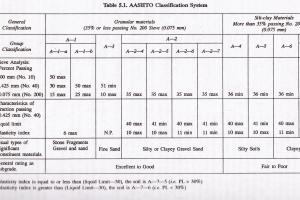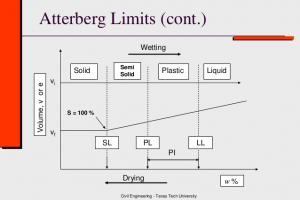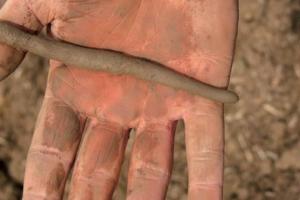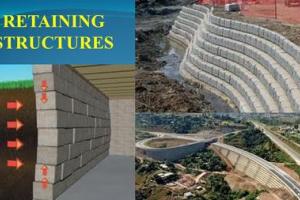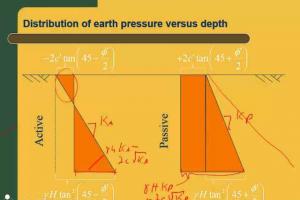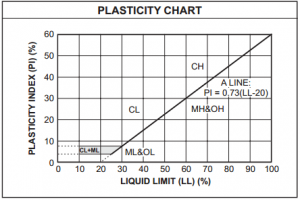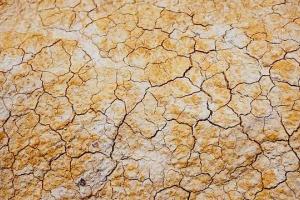Total Stress and Effective Stress Analysis in Soil

Plastic saturated soils (silts and clays) usually have lower shear strength than non-plastic cohesion less soil and are more susceptible to bearing capacity failure. For saturated plastic soils, the bearing capacity often has to be calculated for different condition. Total Stress Analysis (Short term condition) that uses the un-drained shear strength of the plastic soil. Effective stress analysis (Long term condition that uses the drained shear strength parameters (c' & F') of the plastic soil).
Total Stress Analysis
Total stress analysis uses the un-drained shear strength of the plastic soil. The un-drained shear strength (sigma a) could be determined from field tests, such as the vane shear test (VST), or in the laboratory from unconfined compression tests.
If the un-drained shear strength is approximately constant with depth, then sigma a=c and F = 0 For F = 0, the bearing capacity factors are Nc = 5.5, N ? = 0 and Nq = 1 (Put these values in Terzaghi's bearing capacity equation)
(For strip footing)
Q ult = 5.5c + ? Df
Because of the use of total stress parameters the ground water table does not affect the above equation. The ultimate bearing capacity of the above example, the ultimate bearing capacity of plastic soil is often much less than the ultimate bearing capacity of cohesion less soil. This is the reason that building codes allow higher allowable bearing pressure for cohesion less soil (such as sand) than plastic soil (clay).
Also, because the ultimate bearing capacity does not increase with footing width for saturated plastic soils, there is often no increase allowed for an increase in footing width. In some cases, it may be appropriated to use total stress parameters "c" and "F" in order to calculate the ultimate bearing capacity [For example, a structure such as an oil tank or grain elevator could be constructed and the sufficient time elapses so that the saturated plastic soil consolidates under this load. If an oil tank or grain elevator were then quickly filled, the saturated plastic soil would be subjected to an un-drained loading.]
This condition can be modeled by performing consolidated un-drained tri-axial tests (ASTM 4767-02, 2004) in order to determine the total stress parameter (c & F). Based on F value, the bearing capacity factors would be obtained from figure; and then the ultimate bearing capacity would be calculated from equation 1. If site consists of two layers of cohesive soil having different shear strength parameters/properties; Calculate the ratio of the un-drained shear strength of layer 2 to the un-drained shear strength of layer 1 i.e.
c2/c1 = su2/su1
Determine the ratio T/B, where T= vertical distance from the bottom of the foundation to the top of the layer 2 and B = width of the foundation. Enter the values (c2/c1) in graph, intersect appropriate T/B curve, and determine the value of Nc For strip footing; F = 0 (N ? = 0 Nq = 1).
Effective stress Analysis
The principle of effective stress states that the effective stress (denoted by a prime) is the total stress minus the pore water pressure.
σ' = σ - u
The principle of effective stresses applies only to normal stresses and not shear stresses. Deformations of soils are functions of effective stresses and not total stresses. The particle contact stress is not the effective stress. Rather it is the average stress on a plane through the soil particles
The effective stress analysis uses the drained shear strength (c' & F') of the plastic soil. The drained shear strength could be obtained from tri-axial compression tests. This analysis is termed as long term analysis because the shear induced pore water pressure from the loading have dissipated and the hydrostatic pore water conditions now prevail in the field. Because an effective stress analysis is being performed the location of the ground water table must be considered in the analysis.
The first step to perform the bearing capacity analysis would be to obtain the bearing capacity factors (Nc, NÝ, Nq) from Fig; using the value of F'. An adjustment to the total unit weight may be required depending on the location of the ground water table. Then Terzaghi's bearing capacity equation would be utilized (with c' substituted for c) to obtain the ultimate bearing capacity, with a factor of safety of 3 applied in order to calculate the allowable bearing capacity or pressure.
Calculating Effective Stress
- At groundwater level, the porewater pressure is zero
- Below the groundwater level the porewater pressure is positive and the effective stress decreases
- Capillary action causes water to rise above the groundwater level and results in negative porewater pressure. The effective stress increases.
- Groundwater above the ground surface does not increase the effective stress at any point in the soil mass below.
Governing case:
Total stress analysis will provide a lower allowable bearing capacity for soft or very soft saturated plastic soils. This is because load will consolidate the plastic soil leading to an increase in the shear strength as the time passes. For long term case, the shear strength of the plastic soil is higher with a resulting higher bearing capacity. Effective stress analysis will provide a lower allowable bearing capacity for very stiff or hard saturated plastic soils.
Firm to stiff plastic soils are intermediate condition. The ORC and the tendency of the saturated plastic soil to consolidate (gain shear strength) will determine whether the short term condition or the long term condition provides the lower bearing capacity. Bearing capacity analysis for granular soils Granular soil does not liquefy, but rather there is a reduction in shear strength due to an increase in pore water pressure.
Examples include sands and gravels that are below the ground water table and have a factor of safety against liquefaction is greater then 2 the earthquake induced excess pore water pressure will typically be small enough that its effect can be neglected. Using the Terzaghi's bearing capacity equation and an effective stress analysis and recognizing that sands and gravels are cohesion less (i.e. c' = 0) Terzaghi's bearing capacity equation
Qult = cNc + q'Nq + 1/2 t BN
For cohesion less soil
Qult = 1/2 t BN? + t Df Nq
For shallow foundations, it is best to neglect the second term (?t Df Nq) in equation 2. This is because the term represents the resistance of soil located above the bottom of the footing, which may not be mobilized for punching shear failure. So, Qult = 1/2 ?t BN?
Cohesion less soils include gravel, sands Cohesion less soil develops its shear strength as a result of frictional and interlocking resistance between the individual soil particles. This is due to confining pressure. In case of cohesion less soil c = 0
Qult = cNc + q'Nq + 1/2 ?t BN?
First term c = 0
Qult = qNq + 1/2 ?t BN?
For cohesion less soil the location of the ground water table can effect the ultimate bearing capacity. The depth of the bearing capacity failure is often assumed that the soil involved in the bearing capacity failure extends to a depth equal to width of footing. Thus for a ground water table located in this zone, change the third term in the above equation.



